If you want to know how to grow large garlic in your garden, follow the helpful tips from experienced summer residents
The question of how to grow garlic with large heads is of interest to all summer residents. The healing properties of this wonderful vegetable crop are widely known. It is tasty and nutritious, indispensable in the fight against garden pests, and is resistant to adverse external conditions. Therefore, it is difficult to imagine a summer cottage or garden plot without garlic. And most of his admirers hope to put large heads of garlic in the winter bins.
Our article will reveal to you the secrets of growing large garlic from experienced gardeners.
The content of the article
Choosing a variety: spring or winter
Each of them has both advantages and disadvantages.... The choice of a gardener is due to the understanding of these features.
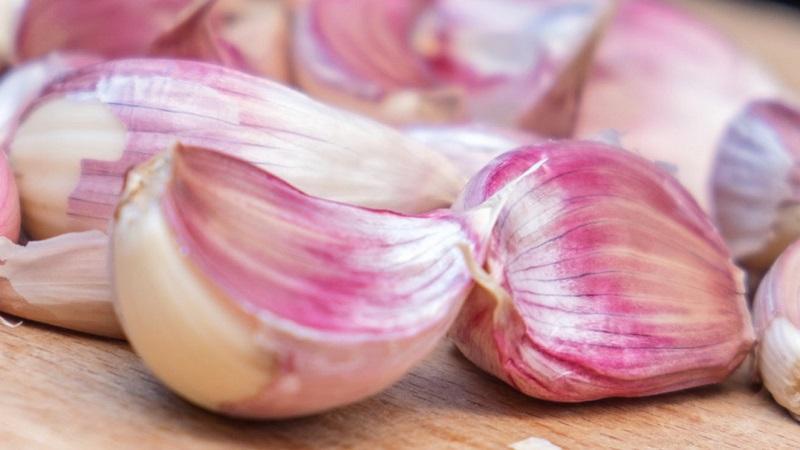
Winter varieties:
- winter well under snow at low temperatures (up to -40 ° on the surface);
- resistant to disease;
- have a rich, pungent taste;
- are distinguished by high productivity;
- bring large onions with neat, even teeth;
- harvesting in late July - early August;
- shelf life - up to 4 months.
Spring varieties:
- at the planting stage, they require preliminary germination;
- low yield in comparison with winter crops;
- large heads are obtained only from special varieties (for example, Gulliver);
- teeth of different sizes;
- ripens by the end of August;
- storage time - up to two years.
How to grow large winter garlic
Concerns for the well-being of winter garlic begin in late autumn and last until the end of the summer season next year.
Site selection and preparation
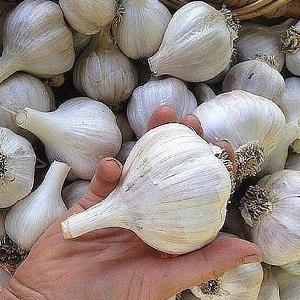 Garlic loves the sun, so choose an open area... The soil is favorable for the development of the plant, on which vegetables (except for onions, potatoes, eggplants and garlic) and legumes previously grew. If, when harvesting, there were already signs of trouble in this area (diseased plants, for example), sowing mustard or calendula in advance will heal the land.
Garlic loves the sun, so choose an open area... The soil is favorable for the development of the plant, on which vegetables (except for onions, potatoes, eggplants and garlic) and legumes previously grew. If, when harvesting, there were already signs of trouble in this area (diseased plants, for example), sowing mustard or calendula in advance will heal the land.
They begin to dig the land for winter crops in early September two weeks before the intended landing. Garlic needs loose soil with neutral acidity. If it is clay or sandy, add peat. Acidic soil is treated with ash solution (glass in a bucket of water) or lime (250 g per m²).
The next step is fertilizing... Experienced summer residents do not use fresh organic matter, which becomes a source of fungal infection of plants. The humus from last year's mowed oats, buckwheat, clover, alfalfa (bucket per m²) is considered an ideal top dressing for young bulbs wintering in the ground. From mineral fertilizers - superphosphate (30 g / m²) and potassium salt (20 g / m²).
Sowing preparation
The sowing season begins with the processing of the planting material. Disinfect by placing the cloves for 45 minutes in a 1% solution of potassium permanganate (10 g per 10 L of water) or by immersion in a solution of copper sulfate (1 g per 10 L of water) for 15 minutes. All liquids are at room temperature. The procedure is completed by rinsing with copious running water.
Important! Protection against infectious and fungal diseases is provided to the plant only by thorough disinfection of the planting material.
Features of planting garlic
In the case of winter crops, the issue of timely planting in the ground is at the head of the whole process.... A mistake is fraught with the loss of up to 30% of the crop.
Timing selection
Traditionally, planting is carried out in September-October.... Garlic planted too early in prolonged warm weather will sprout and die from the first frosts. The winner will be the gardener, who keeps track of the patterns of seasonal changes in the weather in his region from year to year.
Knowing the approximate timing of the onset of a stable cold snap, calculate the most favorable moment for planting - three weeks before the expected frost. This is how much time it takes for a plant to strengthen the root system - the main condition for its well-being in the winter cold.
Landing rules
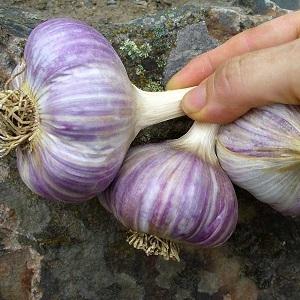 Actions are aimed at creating the most comfortable wintering conditions for the plant:
Actions are aimed at creating the most comfortable wintering conditions for the plant:
- the beds are prepared high (up to 8 cm) with grooves at a distance of 25 cm from each other;
- large teeth are chosen for sowing;
- they are placed vertically in grooves every 10-12 cm to a depth of at least 15 cm, sprinkling with earth;
- watered dry soil after planting;
- the soil is covered from above with straw, leaves, rotted sawdust (they will protect the crops from the cold until the snow falls).
Important! In order to avoid freezing, it is necessary to deeply deepen and reliably insulate the sown garlic.
Planting garlic in large heads
Gardeners are increasingly using this unique method of sowing with whole heads. "Lazy" or bush landing has a number of undeniable advantages before conventional seeding with single cloves:
- saves the time of the gardener;
- beneficial in conditions of a shortage of space at the summer cottage;
- convenient for spot planting, for example, among other crops or around fruit trees.
The procedure for seedbed preparation is the same... The heads are carefully selected and disinfected in a saline solution (2 tablespoons per 2 liters of water). Immediately before planting in the ground, carefully peel off the upper skin and cut off the roots sticking out from below. Immerse in the prepared hole and sprinkle with earth.
Such a garlic grows in a bush, under which several young heads ripen at once... It is believed that these heads are predominantly small. However, practice does not confirm this opinion. Dacha experimenters confidently demonstrate large garlic grown in such an unusual way.
Read also:
How to prepare beds for garlic before winter
Growing technology
Sprout care involves creating a smart watering system, fertilizing the soil and controlling pests.
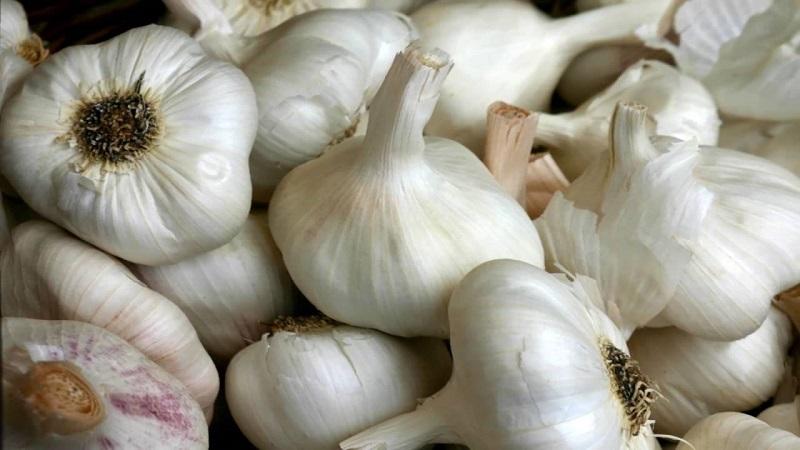
Correct watering and feeding
As soon as the earth dries up from the spring floods, the irrigation campaign begins... The main criterion that determines the frequency of watering is the condition of the soil. It doesn't have to be dry. Hence the approximate frequency: 2-3 times a week during the dry season. Watering is better with water warmed up in the sun. Subsequent weeding solves two problems at once: it removes the weeds from the bed and provides oxygen access to the roots.
Important! Watering is stopped a month before harvesting.
Regular hydration and feeding are especially important during the period of active plant growth.... They begin to apply fertilizers for winter crops in early spring, as soon as the melted snow melts. Monthly treatment with a urea solution (200 g / 10 l of water) will provide the plant with the necessary nutrients for the entire ripening period. Poor soils are enriched twice a month with potassium sulfate or ammonium nitrate (50 g / m²).
Important! Fertilizer is better absorbed if you combine top dressing with watering.
Little secrets of an experienced gardener
Some tips:
- Garlic does not tolerate both drought and waterlogging... It is difficult for a novice summer resident to find a middle ground.The solution to the problem is mulching the beds. Sawdust, straw, shavings, expanded clay, laid at the base of the plants, will protect the soil from excessive drying out and provide a comfortable level of moisture. And you will be relieved of the need to often water and loosen the ground.
- The increase in the size of the garlic heads contributes regular shortening of growing arrows up to 5 cm from the surface. Be careful and harvest large garlic in the fall.
Diseases and pests
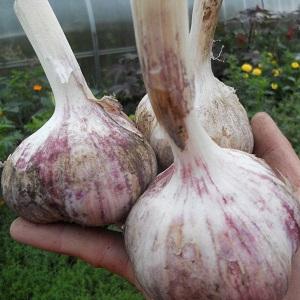 The appearance of a gray mealy bloom on the stem and leaves indicates a fungal infection... White, cervical, bacterial rot, downy mildew penetrate into plant tissues and destroy them. Only preventive measures are effective against these diseases: treatment of planting material with septic tanks.
The appearance of a gray mealy bloom on the stem and leaves indicates a fungal infection... White, cervical, bacterial rot, downy mildew penetrate into plant tissues and destroy them. Only preventive measures are effective against these diseases: treatment of planting material with septic tanks.
Significantly reduces the risk of infection by applying superphosphate to the soil in early spring (100 g per 10 l of water). Diseased plants are removed from the garden as early as possible and burned. And healthy ones are treated with fungicides or sprayed with a solution of soda ash and grated laundry soap (40 g each for 10 liters of water).
Stem nematode, centipede, bear, onion fly and aphids more often than other insects harm young shoots of garlic... The nematode feeds on plant juices and slows down its growth: the leaves curl, the roots rot. Its danger is enhanced by the ability to stay in the soil for many years in a state of suspended animation, waiting for favorable conditions.
In this case soil treatment before planting with a solution of sodium chloride will help (20 g / 3 l of water per m²). The onion fly gnaws the garlic teeth from the inside. Pollination with a mixture of ash (100 g), ground pepper and tobacco (5 g each) helps against the pest.
Important! Chopped fresh mint leaves scattered between rows are a universal remedy for repelling most pests.
Harvesting and storage of crops
Timely removal from the beds is extremely important for garlic: too early or late harvesting will equally negatively affect the quality and shelf life of the crop.
The following signs of cultural maturity serve as a guideline:
- calendar (late July - early August);
- the duration of the vegetative period (100-110 days from germination);
- yellowed lower leaves creeping along the ground.
Important! Ripe air bulbs (bulbs) are considered the most reliable reference point for the beginning of the harvest.
The next step is preparation for storage... To protect against root mites, the heads peeled from the ground and tops are dried for 7-10 days in the open air or in a warm, well-ventilated room. Garlic stored in storage needs regular ventilation. Therefore, as packaging, it is preferable to have openings boxes or boxes, as well as nets.
Important! The largest heads will serve as an excellent seed for next winter crops.
Features of growing large spring garlic
If winter garlic is genetically located to bear large fruits, then a spring crop requires adjustments to the technology of its cultivation:
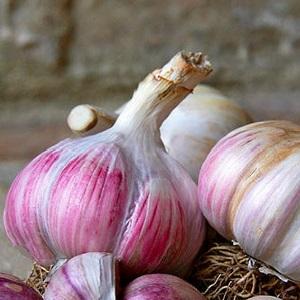 The soil for spring crops is not prepared in spring, but in autumn: dig up, fertilize, disinfect with a solution of potassium permanganate and leave to winter under a film.
The soil for spring crops is not prepared in spring, but in autumn: dig up, fertilize, disinfect with a solution of potassium permanganate and leave to winter under a film.- Selecting a variety ensures 80% success in obtaining large garlic. The spring variety Gulliver has proven itself well.
- Planting material, placed in the refrigerator for 2-3 weeks before sowing, will give seedlings that are resistant to the vagaries of weather and diseases.
- Treated with potassium permanganate solution or copper sulfate, the teeth are either soaked for 12 hours in a growth stimulator, or germinated in a damp cloth.
- Planted in the ground in the first half of Aprilas soon as the snow melts.
- Plant growth stimulation measures and early sowing is aimed at accelerating head formation before the hot season. In this case, spring garlic will grow large.
- Planting depth may not exceed 5 cm.
- Sown beds mulch straw, sawdust, peat until sprouts appear.
- Harvest falls at the end of August-September.
These are the most important recommendations of specialists for growing large spring garlic.... Otherwise, the above rules for caring for winter crops apply to spring crops.
Good to know:
Popular questions
How to choose slices for planting?
In order for the culture to please with a plentiful and high-quality harvest, only bulbs with large cloves are selected for sowing... Sick, small, accrete are subject to rejection.
What is the difference between spring and winter garlic?
It is important to know the signs that distinguish the sowing material of winter and spring crops... The heads of winter garlic have an even number of cloves of the same size, which are grouped around the stem. Spring varieties are distinguished by an arbitrary number of slices of different sizes and the absence of a rod.
Why do the arrows break out?
It is believed that systematic shortening of the ground part to 5 cm enhances the nutrition of the bulb and promotes the formation of larger heads.
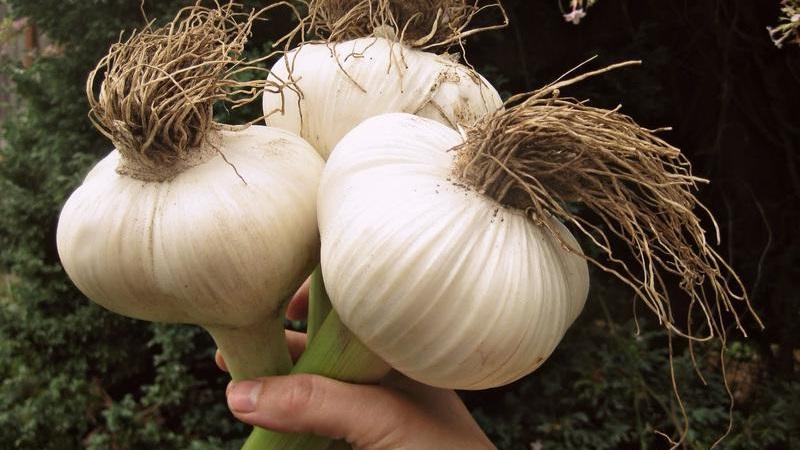
Tips for Harvesting Large Garlic
A few more tips from experienced gardeners:
- Responsible approach to variety selection: Seed from a fine-toothed variety will not produce the desired result.
- Compliance with the rules of crop rotation: prepare the site in advance, plant it in the ground and harvest in a timely manner, water, fertilize and mulch.
- Growing garlic in one area no more three seasons in a row, otherwise the culture will begin to degenerate.
- Planting material update every three years.
- Systematic cutting off arrows will provide the bulbs with additional nutrients.
Conclusion
The successful cultivation of any garden crop requires an understanding of its unique characteristics. The correct choice of variety, skillful preparation of the land plot before planting and knowledge of all the intricacies of caring for a ripening plant will allow you to get results in accordance with your expectations.
But sometimes this is not enough. The observant experimenter is always one step ahead of his more conservative dacha neighbors. Using the latest agricultural advances in combination with existing experience can work wonders. And the recommendations of experienced gardeners will help you to enjoy the abundant harvest of large garlic in your summer cottage from year to year.